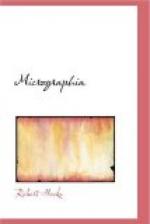After I had almost compleated these Pictures and Observations (having had divers of them ingraven, and was ready to send them to the Press) I was inform’d, that the Ingenious Physitian Dr. Henry Power had made several Microscopical Observations, which had I not afterwards, upon our interchangably viewing each others Papers, found that they were for the most part differing from mine, either in the Subject it self, or in the particulars taken notice of; and that his design was only to print Observations without Pictures, I had even then suppressed what I had so far proceeded in. But being further excited by several of my Friends, in complyance with their opinions, that it would not be unacceptable to several inquisitive Men, and hoping also, that I should thereby discover something New to the World, I have at length cast in my Mite, into the vast Treasury of A Philosophical History. And it is my hope, as well as belief, that these my Labours will be no more comparable to the Productions of many other Natural Philosophers, who are now every where busie about greater things; then my little Objects are to be compar’d to the greater and more beautiful Works of Nature, A Flea, a Mite, a Gnat, to an Horse, an Elephant, or a Lyon.
* * * * *
MICROGRAPHIA,
OR SOME
Physiological Descriptions
OF
MINUTE BODIES,
MADE BY
MAGNIFYING GLASSES;
WITH
OBSERVATIONS and INQUIRIES thereupon.
* * * * *
Observ. I. Of the Point of a sharp small Needle.
As in Geometry, the most natural way of beginning is from a Mathematical point; so is the same method in Observations and Natural history the most genuine, simple, and instructive. We must first endevour to make letters, and draw single strokes true, before we venture to write whole Sentences, or to draw large Pictures. And in Physical Enquiries, we must endevour to follow Nature in the more plain and easie ways she treads in the most simple and uncompounded bodies, to trace her steps, and be acquainted with her manner of walking there, before we venture our selves into the multitude of meanders she has in bodies of a more complicated nature; lest, being unable to distinguish and judge of our way, we quickly lose both Nature our Guide, and our selves too, and are left to wander in the labyrinth of groundless opinions; wanting both judgment, that light, and experience, that clew, which should direct our proceedings.




